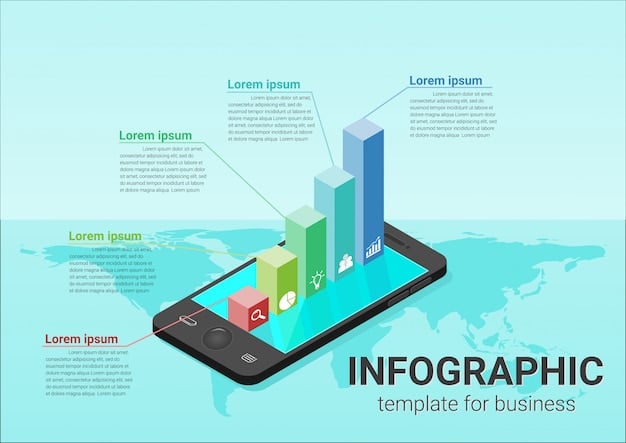Boost Conversions: Mobile Payment Optimization for US E-commerce

Mobile Payment Optimization: How US E-commerce Businesses Can Increase Conversions by 15% in 3 Months involves streamlining the mobile checkout process to reduce friction, enhance user experience, and ultimately boost sales by making it easier for customers to complete purchases on their mobile devices.
Are you struggling with cart abandonment on your e-commerce site? Mobile devices now account for a huge percentage of online traffic and sales. Optimizing the mobile payment experience is no longer optional—it’s a critical strategy for boosting conversions and revenue.
This article explores Mobile Payment Optimization: How US E-commerce Businesses Can Increase Conversions by 15% in 3 Months by focusing on practical strategies and actionable steps that US e-commerce businesses can take to significantly improve their mobile payment processes and see tangible results.
Understanding the Mobile Payment Landscape in the US
The mobile payment landscape is dynamic and rapidly evolving. Understanding its current state is critical for US e-commerce businesses aiming to thrive. Trends like the increasing adoption of digital wallets, the demand for faster checkout experiences, and the growing importance of mobile-first designs are shaping how consumers interact with online stores.
Popular Mobile Payment Methods
Consumers are increasingly using a variety of mobile payment methods. Knowing which ones are preferred by your target audience can directly impact your conversion rates.
- Digital Wallets (Apple Pay, Google Pay, Samsung Pay): Offer a secure and streamlined checkout experience, reducing the need for manual card entry.
- Buy Now, Pay Later (BNPL) Services (Affirm, Klarna, Afterpay): Allow customers to split payments into installments, making purchases more accessible.
- Mobile Payment Apps (PayPal, Venmo): Provide a familiar and trusted option for users who prefer to pay through established platforms.
The Shift to Mobile-First Design
With the majority of online traffic coming from mobile devices, adopting a mobile-first design is essential. This means prioritizing the mobile user experience in every aspect of your e-commerce site, from product browsing to the checkout process.
Optimizing for mobile includes responsive design, streamlined navigation, and mobile-friendly content. By focusing on the mobile experience, businesses can reduce bounce rates and increase time spent on site, ultimately driving conversions.

In conclusion, understanding and adapting to the mobile payment landscape in the US is crucial for improving conversion rates and staying competitive. Embracing popular payment methods and prioritizing mobile-first designs will position e-commerce businesses for success.
Optimizing the Mobile Checkout Process
The mobile checkout process is often the bottleneck for many e-commerce businesses. A clunky, complicated checkout experience can lead to high cart abandonment rates. Streamlining this process is key to improving conversions and retaining customers.
Reducing Friction in the Checkout Flow
Minimizing the number of steps and fields required during checkout can significantly reduce friction. Customers are more likely to complete a purchase if the process is quick and straightforward.
Consider implementing features like guest checkout options, autofill capabilities, and progress indicators to guide users through the process. The goal is to make it as easy as possible for customers to complete their purchase without unnecessary hassle.
Incorporating One-Click Payment Options
One-click payment options provide an even faster and more convenient checkout experience. By allowing customers to save their payment information and complete purchases with a single click, you can greatly reduce the time and effort required.
- Enable Apple Pay and Google Pay: These digital wallets allow users to pay with saved credit cards and shipping addresses, eliminating the need for manual entry.
- Offer Express Checkout Options: Platforms like PayPal and Amazon Pay offer express checkout options that allow users to pay directly from their accounts.
Ensuring Mobile Payment Security
Security is a paramount concern for mobile shoppers. Building trust through robust security measures is vital for encouraging customers to complete their purchases. Displaying security badges and certifications prominently can reassure users that their information is protected. Using tokenization and encryption technologies further enhances security by protecting sensitive payment data.
In summary, optimizing the mobile checkout process involves reducing friction, offering one-click payment options, and ensuring robust security measures. These steps can lead to a smoother, more trustworthy shopping experience, driving significant improvements in conversion rates and enabling Mobile Payment Optimization: How US E-commerce Businesses Can Increase Conversions by 15% in 3 Months.
Leveraging Digital Wallets and BNPL Services
Digital wallets and Buy Now, Pay Later (BNPL) services are transforming the mobile payment landscape. They offer convenience, flexibility, and enhanced security, making them increasingly popular among US consumers.

Integrating these options into your e-commerce site can significantly boost conversions and attract a broader customer base, fostering Mobile Payment Optimization: How US E-commerce Businesses Can Increase Conversions by 15% in 3 Months.
The Benefits of Digital Wallets
Digital wallets, such as Apple Pay, Google Pay, and Samsung Pay, offer several advantages:
- Faster Checkout: Users can pay with a single touch or scan, eliminating the need to enter payment details manually.
- Enhanced Security: Digital wallets use tokenization to protect sensitive payment information, reducing the risk of fraud.
- Increased Convenience: Customers can store multiple cards in one place, making it easier to manage their payments.
The Appeal of Buy Now, Pay Later (BNPL)
BNPL services have gained immense popularity, especially among younger consumers. They allow customers to split their purchases into multiple installments which makes budgeting easier.
By offering BNPL options, e-commerce businesses can increase sales by making products more accessible to a wider audience and achieve Mobile Payment Optimization: How US E-commerce Businesses Can Increase Conversions by 15% in 3 Months.
In conclusion, leveraging digital wallets and BNPL services is essential for US e-commerce businesses looking to optimize their mobile payment processes. These payment options offer convenience, flexibility, and security, which can lead to higher conversion rates and increased customer satisfaction.
Mobile Payment Optimization: Testing and Analytics
Effective mobile payment optimization requires continuous testing and analysis. By monitoring key metrics and conducting A/B tests, businesses can identify areas for improvement and fine-tune their strategies for maximum impact.
A/B Testing Different Payment Options
A/B testing involves comparing two versions of a webpage or process to see which one performs better. In the context of mobile payments, you can test different payment options to see which ones lead to higher conversion rates.
- Test Different Placements: Experiment with different placements of payment buttons to see which ones are most effective.
- Evaluate Different Methods: Compare the performance of digital wallets, BNPL services, and traditional payment methods.
Tracking Key Performance Indicators (KPIs)
Monitoring KPIs is crucial for measuring the success of your mobile payment optimization efforts. Key metrics to track include:
- Conversion Rate: The percentage of users who complete a purchase.
- Cart Abandonment Rate: The percentage of users who add items to their cart but fail to complete the checkout process.
- Average Order Value (AOV): The average amount spent per transaction.
Utilizing Analytics Tools
Analytics tools like Google Analytics and Mixpanel can provide valuable insights into user behavior and payment performance. These tools can help you identify pain points in the checkout process and areas where improvements can be made.
By using data-driven insights, e-commerce businesses can make informed decisions about their mobile payment strategies, leading to improved conversion rates and greater customer satisfaction, contributing to Mobile Payment Optimization: How US E-commerce Businesses Can Increase Conversions by 15% in 3 Months.
In closing, continuous testing and analysis are essential for maximizing the effectiveness of mobile payment optimization efforts. By using A/B testing, tracking KPIs, and leveraging analytics tools, businesses can identify areas for improvement and fine-tune their strategies for optimal results.
Mobile Payment Optimization Examples
To illustrate the impact of effective mobile payment optimization, let’s examine a few real-world case studies and success stories. These examples showcase how different businesses have successfully improved their mobile payment processes and achieved significant gains in conversion rates and revenue.
Case Study 1: Streamlining the Checkout Process
A clothing retailer implemented a simplified checkout process, reducing the number of steps from five to three. They also added autofill capabilities and progress indicators.
The results were impressive: a 20% reduction in cart abandonment rates and a 12% increase in mobile conversion rates. Customer feedback was overwhelmingly positive, with many users praising the ease and speed of the new checkout process.
Case Study 2: Integrating Digital Wallets
An electronics retailer integrated Apple Pay and Google Pay into their mobile checkout process. They also promoted these payment options prominently on their product pages.
Mobile conversions increased by 18% and digital wallets accounted for 30% of all mobile transactions within the first three months. Customers appreciated the convenience and security of using digital wallets.
The key takeaway is that strategic changes to the mobile payment process can yield substantial improvements in conversion rates, leading to Mobile Payment Optimization: How US E-commerce Businesses Can Increase Conversions by 15% in 3 Months.
Case Study 3: Offering Buy Now, Pay Later (BNPL)
A home goods retailer partnered with a BNPL service to offer installment payment options. This made their products more accessible to budget-conscious shoppers.
The retailer saw average order value increase by 25% and a 15% rise in overall sales. BNPL became a popular payment option, particularly among younger customers.
In short, real-world examples demonstrate the significant impact of mobile payment optimization on conversion rates and revenue. By streamlining the checkout process, integrating digital wallets, and offering BNPL options, businesses can create a better mobile shopping experience and drive sales growth. These examples highlight the potential for Mobile Payment Optimization: How US E-commerce Businesses Can Increase Conversions by 15% in 3 Months.
| Key Point 🔑 | Brief Description 📝 |
|---|---|
| 📱 Mobile-First Design | Prioritize mobile UX: streamline navigation & checkout for better engagement. |
| 💸 Digital Wallets & BNPL | Offer Apple Pay, Google Pay & BNPL services to boost conversion rates. |
| 🔒 Payment Security | Build trust with security badges, tokenization, and encryption. |
| 📊 Testing & Analytics | Use A/B tests & track KPIs to fine-tune your payment strategies. |
Frequently Asked Questions
Mobile payment optimization involves streamlining the mobile checkout process to reduce friction and increase conversions. It’s important because a significant portion of e-commerce traffic comes from mobile devices, making a seamless payment experience crucial for driving sales.
To reduce cart abandonment, simplify the checkout process by minimizing steps, offering guest checkout options, and providing autofill capabilities. Clearly display security badges to build trust and ensure a smooth, hassle-free experience.
Integrating digital wallets like Apple Pay and Google Pay offers faster checkout, enhanced security through tokenization, and increased convenience for customers. This leads to higher conversion rates and improved customer satisfaction.
BNPL services can increase mobile conversions by making products more accessible to a wider audience. They allow customers to split payments into installments, which makes budgeting easier and encourages purchases, particularly among younger shoppers.
Key metrics to track include conversion rate, cart abandonment rate, and average order value (AOV). Monitoring these KPIs will help you assess the effectiveness of your strategies and identify areas for improvement in your mobile payment process.
Conclusion
Mobile payment optimization is essential for US e-commerce businesses looking to increase conversions and drive revenue. By prioritizing mobile-first design, streamlining the checkout process, and leveraging payment options like digital wallets and BNPL services, businesses can create a better mobile shopping experience or enabling Mobile Payment Optimization: How US E-commerce Businesses Can Increase Conversions by 15% in 3 Months.
Continuous testing, tracking and a data-driven approach will ensure ongoing success in the dynamic mobile payment landscape. Embracing these strategies can lead to significant improvements in conversion rates and greater customer satisfaction.





